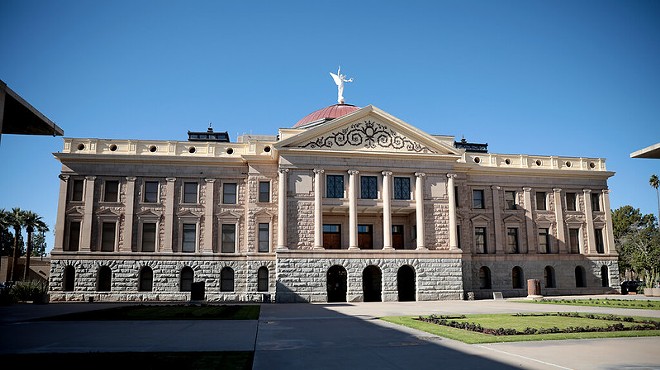Monday, August 6, 2012
UA's HiRISE Snaps Pic of Curiosity's Descent on Mars

- NASA/JPL-Caltech/University of Arizona
- NASA's Curiosity rover and its parachute were spotted by NASA's Mars Reconnaissance Orbiter as Curiosity descended to the surface on Aug. 5
A huge congrats to the UA team running the Lunar and Planetary Lab's HiIRSE camera: They got the timing just right to get a shot of Curiosity as it dropped through the Martian atmosphere. (HiRISE managed to do a similar feat with the landing of Phoenix in 2008.)
The Range made it out last night to Fourth Avenue's Sky Bar, where a cheering crowd watched the NASA feed of Curiosity's entry and descent to Mars' Gale Crater on the bar's big-screen TVs. We have admit that we were a little stunned to see that the Mars Science Laboratory team was able to post the first photo from the Mars Science Laboratory within minutes of the landing. Mind-blowing stuff—and the two-year mission is just getting started. More on that here.
Here's the press release about the HiRISE photo:
An image from the High Resolution Imaging Science Experiment (HiRISE) camera aboard NASA's Mars Reconnaissance Orbiter captured the Curiosity rover still connected to its 51-foot-wide (almost 16 meter) parachute as it descended towards its landing site at Gale Crater."If HiRISE took the image one second before or one second after, we probably would be looking at an empty Martian landscape," said Sarah Milkovich, HiRISE investigation scientist at NASA's Jet Propulsion Laboratory in Pasadena, Calif. "When you consider that we have been working on this sequence since March and had to upload commands to the spacecraft about 72 hours prior to the image being taken, you begin to realize how challenging this picture was to obtain."
The image of Curiosity on its parachute can be found at: http://www.nasa.gov/mission_pages/msl/multimedia/pia15978b.html
The image was taken while MRO was 211 miles (340 kilometers) away from the parachuting rover. Curiosity and its rocket-propelled backpack, contained within the conical-shaped back shell, had yet to be deployed. At the time, Curiosity was about two miles (three kilometers) above the Martian surface.
"Guess you could consider us the closest thing to paparazzi on Mars," said Milkovich. "We definitely caught NASA's newest celebrity in the act."
Curiosity, NASA's latest contribution to the Martian landscape, landed at 10:32 p.m. Aug. 5, PDT, (1:32 on Aug. 6, EDT) near the foot of a mountain three miles tall inside Gale Crater, 96 miles in diameter.
In other Curiosity news, one part of the rover team at the JPL continues to analyze the data from last night's landing while another continues to prepare the one-ton mobile laboratory for its future explorations of Gale Crater. One key assignment given to Curiosity for its first full day on Mars is to raise its high-gain antenna. Using this antenna will increase the data rate at which the rover can communicate directly with Earth. The mission will use relays to orbiters as the primary method for sending data home, because that method is much more energy-efficient for the rover.
Curiosity carries 10 science instruments with a total mass 15 times as large as the science payloads on the Mars rovers Spirit and Opportunity. Some of the tools are the first of their kind on Mars, such as a laser-firing instrument for checking rocks' elemental composition from a distance. Later in the mission, the rover will use a drill and scoop at the end of its robotic arm to gather soil and powdered samples of rock interiors, then sieve and parcel out these samples into analytical laboratory instruments inside the rover.
To handle this science toolkit, Curiosity is twice as long and five times as heavy as Spirit or Opportunity. The Gale Crater landing site places the rover within driving distance to layers of the crater's interior mountain. Observations from orbit have identified clay and sulfate minerals in the lower layers, indicating a wet history.
The mission is managed by JPL for NASA's Science Mission Directorate in Washington. The rover was designed, developed and assembled at JPL.
For more information on the mission, visit http://www.nasa.gov/mars and http://marsprogram.jpl.nasa.gov/msl
Follow the mission on Facebook and Twitter at http://www.facebook.com/marscuriosity, http://www.twitter.com/marscuriosity
HiRISE is operated by the University of Arizona, Tucson. The instrument was built by Ball Aerospace & Technologies Corp., Boulder, Colo. The Mars Reconnaissance Orbiter Project and the Mars Exploration Rover Project are managed by NASA's Jet Propulsion Laboratory, Pasadena, Calif., for NASA's Science Mission Directorate, Washington. JPL is a division of the California Institute of Technology in Pasadena. Lockheed Martin Space Systems, Denver, built the orbiter.
For more about the Mars Reconnaissance Orbiter, see http://www.nasa.gov/mro .
Tags: UA Lunar and Planetary Lab , HiRISE , NASA , curiosity , photo , descent , arizona news , Tucson news


















